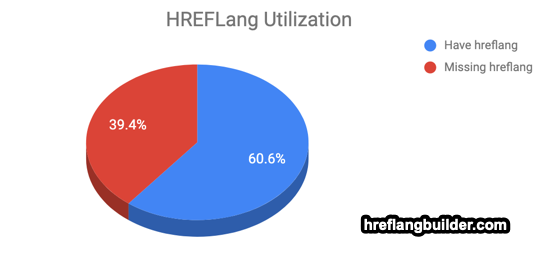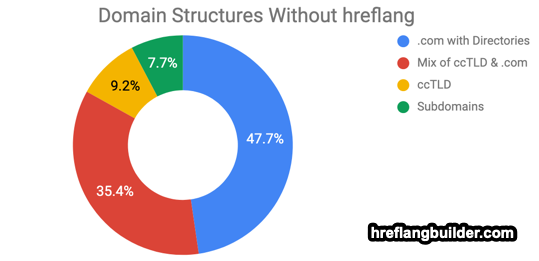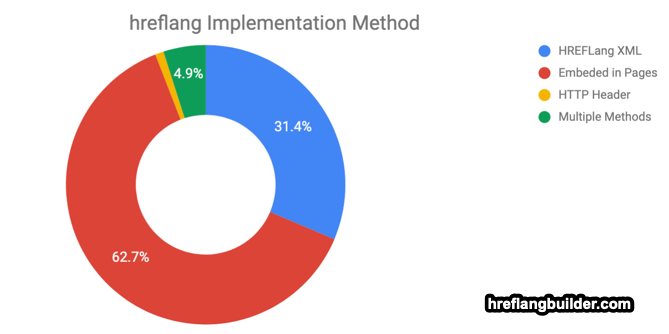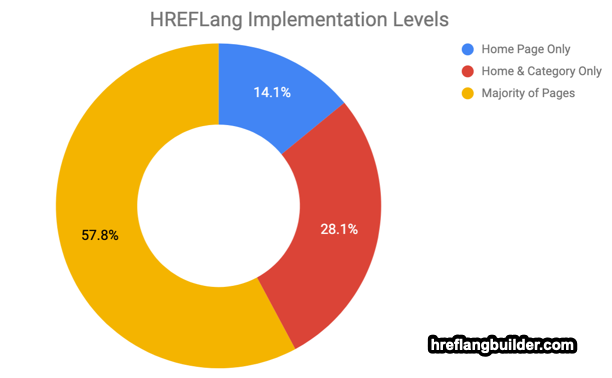
Why your Custom HREFLang Implementation Does not Work
May 7, 2019
Do I need to use HREFLang?
May 23, 2019HREFLang Builder conducted an extensive review of the level of hreflang adoption by 165 of the most localized brand sites. Despite hreflang being a critical element of global SEO, we found that nearly 40% (39.4%) of these companies were not using this crucial markup in their sites.
Google deployed support for multilingual content using HREFLang tags and later XML site maps nearly eight years ago. HREFLang elements let site owners designate what dialect or region their content is targeting. This is helpful when you have different sites for the same language markets, like English, Spanish, and Arabic, but don’t use country-specific domains or host in the market.
For example, If you have a site for the UK and another for Australia and host both on a single dot-com domain with folders designating the country but because both are similar in English the search engine may not know which is which and show a product in British Pounds in Australia. Using hreflang elements you can tell the search engine which version is for each country.
Global Brands Reviewed
To create a list of sites, we started with the list of the most global websites in Byte Level Research’s 2018/19 Web Globalization Report Card. We appended additional global brands to the list from those we have worked with and removed some due to complexities. Those excluded were mostly pharmaceutical, auto, and CPG companies due to their complex brand web structures. The final tally for this first round of research was 165 brands.
Surprising Result – Low Adoption Rates of HREFLang
As we were reviewing the sites and compiling the data there were a few surprises with what we learned.
Given that hreflang elements have been in place for nearly eight years we were surprised at the relatively low adoption rate of only 60.6% of the “most global brands” using any form of hreflang. We only found hreflang in place on 100 of the sites. Given the significant benefits of using hreflang we were surprised this was not more widely adopted

Surprising Result – Website Domain Structures
When I first saw the low implantation rate, I immediately assumed that those not implementing hreflang were those brands using ccTLD’s. Since a domain like .co.uk or .de indicates this is site-specific to the UK or Germany, many SEO’s and Webmasters did not feel the need to implement hreflang.
To my surprise, nearly half of the sites that did not have hreflang implemented used a dot-com domain with some sort of country/language folder structure. If your site uses a /es folder is that Spanish language or Spain? Why does the search engine need to work so hard to figure out your content?

The chart shows the largest domain structure without hreflang was pure dot-com sites followed by sites that had some dot-com and some ccTLD’s.
I was also surprised by the number of brands that were not using ccTLD’s. There has been a big push to move back to locally branded domains for market purposes as well as removing ambiguity to search engines.
Of the 9 brands using only ccTLD’s on the list, only 3 of them had hreflang implemented.
HREFLang Methods of Implementation
There are three methods webmasters can use to implement hreflang elements. You can add them to the code on the page, the server response, or XML site maps. While I am partial to using hreflang XML site maps any of the methods work well.

The hreflang tag seems to be the preferred method used by 63% of the sites followed by XML site maps with 31%. We found 5% were using multiple methods and only 1 site was using the HTTP header method.
Surprising Result – Partial HREFLang Implementation

Some progress in this category where nearly 60% of the sites had hreflang implemented on most pages. We did not do a 100% check of all the brand sites/pages we did a random sampling.
It was a surprise that so many sites only did a partial implementation. 14% of the sites only had HREFLang implemented on the home page. Further surprising are the incorrect assumptions by SEOs and Webmasters.
We have talked to a number of webmasters who incorrectly thought they only needed to add them to the home page since that is the example that Google gives and assumed Google could follow that as a guide for the entire site.
Challenges with Implementation
Given that hreflang has been in place for nearly eight years we are still surprised by how complex it is for companies to implement this critical functionality.
We primarily attribute this lack of adoption and error levels to a couple of main reasons. The first is the hreflang does not really have an owner. Last year we posted an article “Who owns hreflang?” and not much has changed. When we work with brands we often get passed around to the search team, web team, and even the localization teams none of which want to take ownership.
Second, there is no real technical guide on how to do it. Every day I see incorrect information passed on social media or some other “expert” promoting their ultimate guide that is full of errors or does explain any of the technical elements to implement and manage it. Not to slight anyone, it is really tough to write that sort of guide.
Those that can develop it won’t make it public because someone will rip it off and sell it as their own. Even Google struggles with proper documentation although they have made some updates and I believe are working on even more.
I recently published this article “Why your Custom hreflang Implementation Doesn’t Work” detailing a number of reasons with the majority being confusion, bad specifications, and dysfunctional site structures.
More to come
We are trying to finish up a more formal report with specific examples and recommendations and hope to get that out in the next month. If you have questions on any of the data please let me know.
We created HREFLang Builder to make the implementation of HREFlang easier. The HREFLang Builder has automated 100% correct HREFLang sitemaps for over a billion pages and contributed to over 100 million dollars in incremental revenue for clients. Does your HREFLang implementation make the grade? If not sign up today or contact us to take a look.


